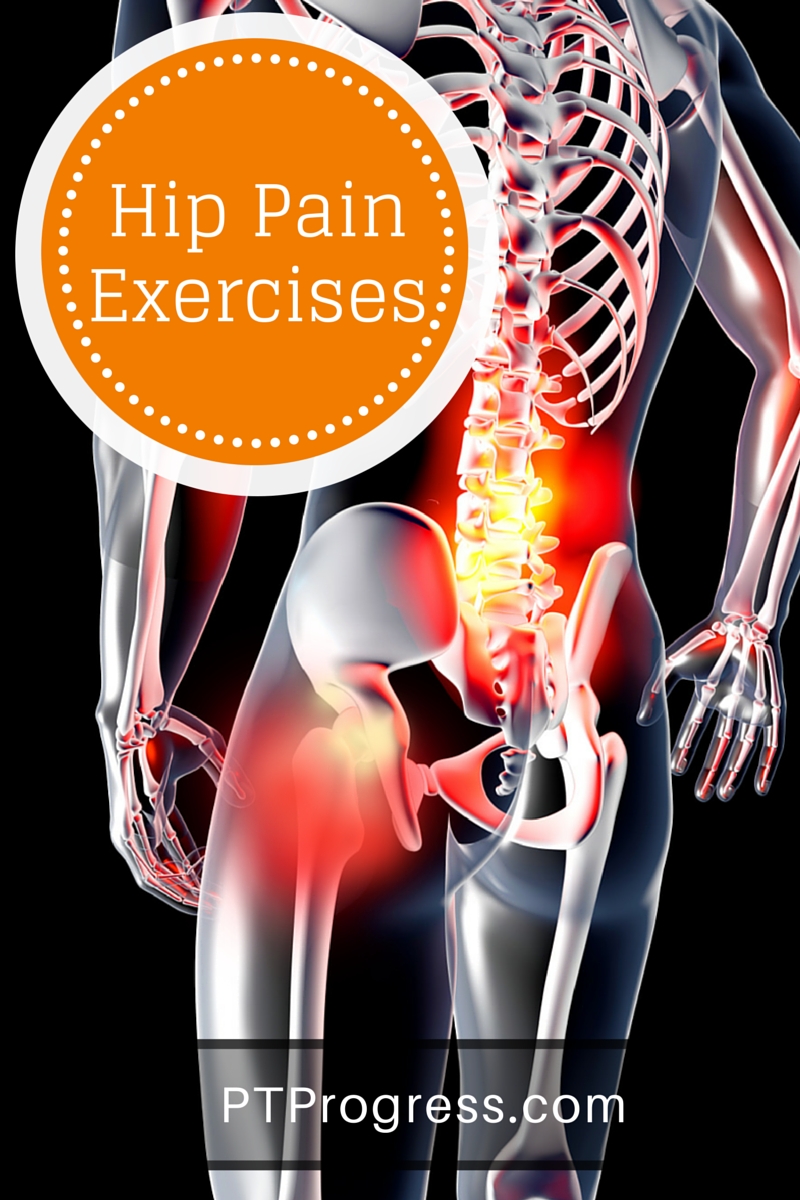 My Hip Hurts: What Can I Do About It?
My Hip Hurts: What Can I Do About It?
Pain in the hip is one of the most common complaints of runners, dancers, cyclists, and especially those who have a desk job. Often, hip pain with standing, walking, or running can leave a person limping, especially after prolonged sitting or a long walk.
Before we talk about exercises to improve hip mechanics, it’s important to inform your physician about hip pain when walking or running. A thorough exam can help to identify common hip pain causes, which can include these diagnoses:
- Osteoarthritis
- Hip fractures
- Labral Tears
- Bone Infection or Cancer
- Bursitis
- (Hip Flexor) Iliopsoas Tendonitis: Also called ‘Snapping Hip’
- Femoro-acetabular impingement (FAI)
- Hamstring strain
- Iliotibial Band Syndrome
- Adductor / Groin Strain
Conservative Hip Exercises for Hip Pain
Before starting any exercise program, it is critical to consult with a physician and a physical therapist in order to assess your individual case. Here are some key points to remember with any exercise program:
- All of the exercises below focus on restoring precise movement of the hip.
- Precise motion without pain is the key to any restorative hip exercise plan.
- Quality over Quantity – Each motion should be precise, controlling for unwanted hip rotation.
- The lower abdominals are key to controlling hip rotation, which is often the mechanical fault that leads to imprecise spinning of the ball and socket, and also pain. This is why low abdominal exercise is emphasized so much here.
- Not all exercises are right for everyone. It’s important to have a professional diagnose the cause of the pain and to reference this list as a supplemental guide for their approval.
Lower Abdominal Strengthening is Key
Why Strengthen the Low Abs?
The lower abdominals control rotation of the hip and keep it from rotating unnecessarily during lower extremity movements (such as walking and running).
The hip should be able to work independently of the back, maintaining its stabilization through the lower abdominals. When the low abs are weak, movements like walking and running can lead to uncontrolled rotation in the hip and subsequent low back pain and hip pain.
How to Strengthen the Lower Abdominals:
Heel Slides
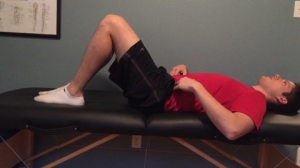 The easiest way to strengthen lower abdominals is to perform a heel slide correctly.
The easiest way to strengthen lower abdominals is to perform a heel slide correctly.- Starting position is lying in supine (facing up) with both knees flexed to 90˚ so that each hip is also at 45˚ of flexion. Breathe normally through all motions.
- Contract the lower abdominal muscles by pulling the bellybutton into the
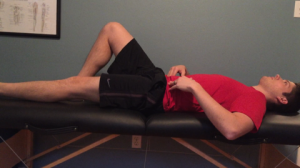 spine and keeping the low back flat on the surface.
spine and keeping the low back flat on the surface. - If this position is pain free, slide one leg down at a time. If a snapping hip occurs, try pressing lightly into the table with the heel by contracting the glutes slightly.
- Return one leg at a time contracting the lower abdominals and keeping a flat back.
Bent Knee Fall Outs
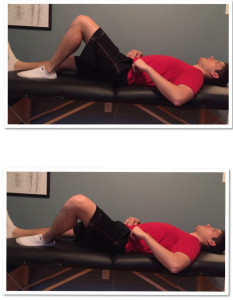 Another easy exercise to stabilize the hip through lower abdominal contraction is the bent knee fall out.
Another easy exercise to stabilize the hip through lower abdominal contraction is the bent knee fall out.- The purpose of this exercise is to move the legs without moving the pelvis while also providing a stretch to the inner thigh muscles.
- Starting position is lying in supine (facing up) with one knee flexed to 90˚ so that the hip is also at 45˚ of flexion. Breathe normally through all motions
- Contract the lower abdominal muscles by pulling the bellybutton into the spine and keeping the low back flat on the surface.
- Keeping the pelvis still (monitor by placing hands on hips), lower the knee out towards the side slowly. If the pelvis rotates at all, stop and limit motion to this point. If pain occurs, stop and only perform through pain free range.
- Return to the starting position and perform 8-10 times per side
Low Abdominal Progression

Keys to exercise:
• Breathe
• Bellybutton to Spine
• Keep Low Back Flat
• Avoid pelvic rotation by using low abs
• Slow and Precise Movements are Key
Steps to Perform
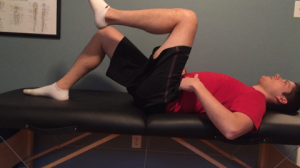 Lying in supine (face up), contract the abdominal muscles by pulling in the bellybutton towards the spine. The low back should round flat onto the surface.
Lying in supine (face up), contract the abdominal muscles by pulling in the bellybutton towards the spine. The low back should round flat onto the surface.- With knees starting in a bent position, flex one hip towards the chest while keeping the other knee bent and on the surface, holding for 3 seconds.
- Return the flexed limb to the surface and repeat with the opposite limb.
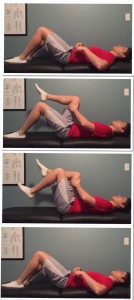
If the low back arches up, use option 2.
Lower Abdominal Option 2:
- Lying supine (face up), contract the abdominal muscles by pulling in the bellybutton towards the spine. The low back should round flat onto the surface.
- With knees starting in a bent position, flex one hip towards the chest while keeping the other knee bent and on the surface.
- Hold the flexed hip with your hands to maintain a flat back. While contracting the abdominals, flex the other hip so that both hips are lifted from the surface, hold for 3 seconds.
- Return each leg to the starting position.
- Repetitions: 5-6 times as long as the back remains flat and there is no pain.
How to Progress Low Abdominal Strengthening
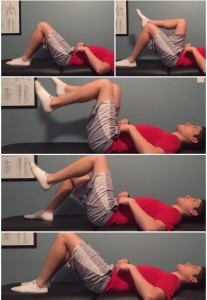
Lower Abs Level 1:
- Lying supine, flex both knees to 90˚ so that each hip is also at 45˚ of flexion.
- Contract low abs (bellybutton to spine), keeping low back flat on table, flex one hip just past 90˚ towards the chest.
- Keeping abdominals contracted and back flat, bring second hip to chest. Hold both for 3 seconds.
- Maintain the contraction while lowering one leg at a time to the starting position.
Progress this version by only bringing hips to 90˚ of flexion. This is more difficult and rotation should be monitored as well as low back position. All movements should be pain free.
Lower Abs Level 2
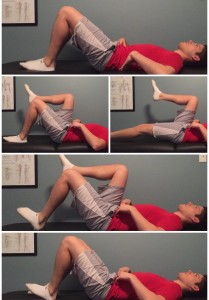 Lying supine, flex both knees to 90˚ so that each hip is also at 45˚ of flexion.
Lying supine, flex both knees to 90˚ so that each hip is also at 45˚ of flexion.- Contract low abs (bellybutton to spine), keeping low back flat on table, flex one hip just past 90˚ towards the chest.
- Slide the opposite foot (still in starting position) towards the end of the table to fully extend the leg. Keep it on the surface.
- Slide the leg back to the starting position and lower the flexed hip to the starting position.
- Repeat sequence with opposite side.
Lower Abs Level 3
- Same as Level 2 but keep the foot 2” off the table while extending the foot.
Quadruped Rocking
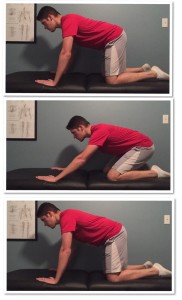
The goal of the quadruped positional exercises is to engage the lower abdominals while performing pure hip flexion without rotation. In the arm lift version, the goal is to prevent hip rotation by contracting the lower abs before moving.
- In the hands and knees position, maintain a flat back and practice bringing the bellybutton towards the spine to engage the lower abdominals.
- With a contracted abdominal and flat back, rock backwards while maintaining the tightened abdomen. Rotation at the hips should not occur. If rotation occurs, rocking back should be limited to this point.
- Return to the starting position. At no point should the motion be painful. If pain exists in the front hip, round the low back slightly before rocking back and limit the range.
- Perform 8-10 repetitions with precise motion and no pain.
Quadruped Arm Lift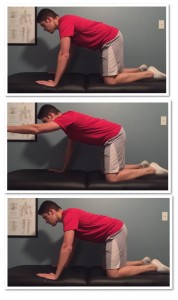
- In the hands and knees position, maintain a flat back and practice bringing the bellybutton towards the spine to engage the lower abdominals.
- With a contracted abdominal and flat back, raise one arm into flexion so it is parallel to the ears.
- The pelvis should not rotate when performed correctly.
- Return to the starting position. At no point should the motion be painful.
- Perform 8-10 repetitions with precise motion and no pain.
Prone Knee Flexion
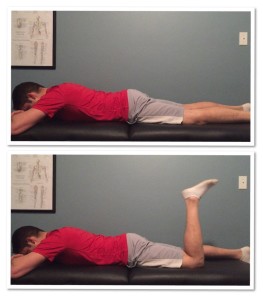 The goal of this exercise is to control the hip and prevent it from rotating while flexing the knee.
The goal of this exercise is to control the hip and prevent it from rotating while flexing the knee.- Lying face down with the legs straight, contract the lower abdominals.
- Slowly and lightly bend the knee to 90˚ while making sure the pelvis does not rotate.
- If needed, a pillow should be placed under the hips to make it easier to control rotation.
- Return to the starting position. At no point should the motion be painful.
- Perform 8-10 repetitions with precise motion and no pain.
Prone Hip Extension
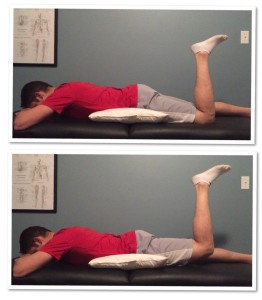 The goal of this exercise is to strengthen the gluteus maximus muscle and to learn to contract it before the hamstrings. Always use 1-3 pillows under the pelvis.
The goal of this exercise is to strengthen the gluteus maximus muscle and to learn to contract it before the hamstrings. Always use 1-3 pillows under the pelvis.- Lying face down with the legs straight, and hips on pillows, contract the lower abdominals.
- Slowly and lightly bend one knee to 90˚ while making sure the pelvis does not rotate and the back does not arch.
- Contract the gluteal muscles to lift the thigh off of the surface. The glutes should contract before the hamstrings.
- Hold for 3-10 seconds and return to the starting position. At no point should the motion be painful.
Clamshells (Modified Version)
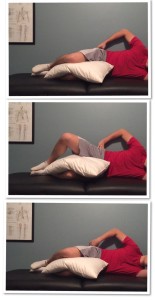
The goal of the clamshell exercise is to strengthen the lateral roators of the hip and to control for rotation by using the lower abdominals. It is important to watch for rotation and lateral tilting of the pelvis and to only move in a painfree range.
If the standard position is painful, try placing a pillow between the knees to shorten the distance.
- Lying on the side with the trunk level with the hips and head, bend the knees to 90˚.
- Contract the low abdominals and slowly hinge at the hip to lift one knee towards the ceiling. The feet should stay together.
- Do not let the pelvis rotate forward or backward. If needed, perform against a wall to control for rotation.
- Lower the leg and repeat 8-10 times, focusing on using the gluteal muscles and keeping the pelvis still. At no point should the motion be painful.
Tall Stance with Forward Bend
- The goal of this exercise is to recruit and strengthen the gluteus maximus muscles while extending at the hips.
- Standing tall with knees unlocked, keep a flat back by contracting the abdominals and tilting the pelvis posteriorly (back).
- Moving as a unit, bend forward at the hip slightly while keeping a flat back.
- To return to standing, contract the glutes and drive up using the buttocks muscles.
- Perform 8-10 repetitions with precise motion and no pain.
Pole Squat
- The goal of the pole squat is to strengthen the gluteus maximus muscle while performing precise hip flexion and extension.
- Standing tall in front of a countertop or supporting structure, hold arms out to 90˚ for support.
- Slowly and without pain, lower into a squat position so that knees are at 90˚ and hips are at 90˚ (don’t move as far if too difficult).
- The return is the key of the exercise. Squeeze the glutes to return to standing.
- Perform 8-10 repetitions with precise motion and no pain.
Sit to Stand
This overlooked activity is performed multiple times a day incorrectly and with pain. Treat it as an exercise to develop precise hip motion and pelvic control.
- From a seated position, bend at the hips to bring the ‘nose over the toes.’
- Drive pressure through the heels and activate the gluteus maximus to lead the motion. This is key: the gluteus maximus needs to fire to assist with precise hip motion.
- Keep the knees pointing straight. Do not let the knees move inward past the toes. This is medial rotation and adduction of the hips and should be avoided.
- Perform throughout the day, keeping the knees from moving inward and always contracting the glutes to lift up.
Difficulty Contracting the Glutes?
For some people, it’s difficult to know if they’re even contracting the glutes during activities. It’s a muscle that can be neglected, which makes it challenging to recruit.
The simplest way to contract the glutes is in a standing position with the knees slightly bent. Squeezing the buttocks in the standing position is a great way to start to feel a contraction. Throughout the day, standing and contracting the glutes 8-10 times will make it easier to recruit this large muscle group during functional activities like walking, running, and sitting up.
Postural Adjustments
Everyday posture can contribute to hip pain. A slumped posture (swayback) where the knees are locked into hyperextension and the pelvis is tilted back can often cause hip pain in the front of the thigh.
Keep in mind these postural cues throughout the day:
- Stand with Soft Knees (Unlock the Knees!)
- Contract the abdomen (Bring Bellybutton to Spine)
- Don’t Cross Legs in Sitting
- Don’t Let Legs Cross in Sleeping – (Keep Pillow Between Knees)
- Contract the Glutes in Standing and on Heel Strike
- Stop All Straight Leg Raises Immediately
Controlling Hip Pain in Walking
Walking with hip pain is not a good exercise. Period. The same is true for running.
However, giving up walking altogether is not an option for most people, so managing hip pain with walking is important. Here are some options:
Contract Glutes on Heel Strike
When taking a step, think about contracting the glutes on that side with each step. The glutes help to extend the femur and position it precisely in the hip socket (acetabulum). If the glutes aren’t recruited in walking, the hamstrings dominate and have a tendency of tipping the femur forward (anteriorly) since the insertion is so low on the femur and onto the tibia. This can cause hip pain in the front so the bottom line is to try contracting the glutes as the heel hits the ground.
Use a Cane or Walking Stick
No, a cane isn’t glamorous. But neither is hip pain. Using a cane on the opposite side of the affected hip has been shown in studies to decrease the contact force significantly with walking.
Location of Hip Pain:
Generally hip pain may occur in these key areas:
Front Hip Pain: Along the anterior (front) pelvis, pain can shoot down towards the groin. Placing your hands on your hip, you can feel a tender spot especially when lifting or lowering your leg from a seated or lying position.
Side Hip Pain: On the lateral (outer) side of your leg, pain can be felt at the greater trochanter which can be felt when moving the leg in medial and lateral rotation (log rolling your leg). Sometimes side hip pain can shoot down to the knee.
Posterior Hip – Butt Pain: A deep pain in the buttocks is a common site for hip pain. Often labeled ‘Sciatica’ or ‘Piriformis Syndrome’, this pain can be sharp and shoot down the back of the leg.
Groin Pain: Often times groin pain is associated with hip pain, particularly with Sacroiliac Joint Dysfunction, hip adduction strain, or pubic symphysis dysfunction.
Low Back: The pelvis can actually refer pain to the low back. Through uncontrolled pelvic rotation, the low back can experience a shear or torsional force with activities like walking or running.
It’s important to note where your hip pain is, and when it occurs (during the kinds of activities or movements you’re performing.)
FYI – This article is about 4000 words long, so make sure to Pin it or share it on Facebook so that you can reference it later.
Why Is My Hip Hurting?
The hip is a ball and socket joint where the head of the femur (thigh bone) fits into the acetabulum of the pelvis (socket). A thin fibrocartilage tissue lines the socket to provide stability and to protect the joint surface. Multiple ligaments and muscles insert and cross over the hip, allowing movement in all planes: flexion (thigh to chest), extension (bring thigh backwards), abduction (leg away), adduction (leg to midline), rotation (twist leg in and out), and tilt (hip forward or backward).
Besides the list of hip conditions listed above, a physical injury or trauma to the hip can damage tissue in the area (falling down, car accident, jumping from a high surface, etc.)
What if you didn’t have an injury and your doctor says your hip appears normal?
Hip pain is often linked to mechanical imprecision in the hip. If the head of your femur isn’t precisely rotating in the socket of your hip, you may feel an impingement or sharp pain in the hip. Improper balance of the hip musculature can also lead to hip pain through overuse (especially overuse of the hip flexors – iliopsoas and ITB-TFL the Ilio-Tibial Band / Tensor Fascia Lata). Overuse injuries can lead to inflamed tissues and sharp pain when lifting or lowering the leg.
Muscles of The Hip: The Key to Understanding Hip Pain
You don’t need to be an expert in anatomy to understand the muscles of the hip.
It is important that you understand the basic relationship between the muscles and how the act as a counterbalance to each other. If you have an overuse injury, it’s POINTLESS to stress the injured tissues by moving them through the hurting range. Your focus should be on strengthening the weak supporting muscles, not the already strained muscles.
Before we list out a few exercises for hip pain, here’s an overview of the muscles affecting the hip joint. Each muscle includes exercises to consider, which are detailed later in this article.
Lower Abdominals
Location: The lower abdominals include the external and internal obliques, which attach from the trunk to the pelvis.
Action: The role of the lower abdominals is to control pelvic tilt and rotation in relationship to the spine during lower extremity movements. These muscles keep the pelvis stable.
Common Problems: Without lower abdominal strength, the pelvis and back are unable to move independently. Low abdominal weakness leads to unwanted pelvic rotation with motions, which can lead to low back pain and hip pain with leg movements.
Exercises to consider: Bent Knee Fall Out, Lower Abdominal Progression
Iliopsoas
Location: The iliopsoas originates from the lower back and pelvis and inserts onto the upper part of the outer femur (lesser trochanter).
Action: Its job is to flex the hip and assist in side flexion of the trunk, lateral rotation (turn thigh out), and abduction (move thigh away from body).
Common Problems: The tendon of the iliopsoas near the top of your thigh can rub against the pelvis, creating a snapping sound and a painful feeling. Overuse of the iliopsoas is common due to the inability to relax this muscle. Overuse pain is often felt when raising and lowering the leg.
Exercises to consider: Lower abdominal strengthening, gluteus maximus and medius strengthening.
Tensor fasciae latae:
Location: The TFL originates on the top of your hip (iliac crest and ASIS) and fascia, and inserts into the fascial band on the outer part of your thigh.
Action: Its job is to flex the hip, medially rotate the thigh (turn thigh inward), abduction (move thigh away from body) and assist with knee extension.
Common Problems: The TFL can dominate the movement of hip flexion and become very strong and stiff. Runners who have tight TFLs know how pain on the side of their hip can run down to their knee. The dominance of the TFL will alter the precision of joint motion in the hip, and we know what can happen when the hip joint doesn’t move precisely: pain.
Exercises: Usually the TFL is a very strong, and problematic muscle that gets plenty of exercise, so you won’t find any strengthening tips for it here.
Sartorius
Location: The sartorius begins at the ASIS, which is the top of your hip bone where your belt line sits. It runs diagonally along the front of your thigh and inserts on the inner tibia, just below your knee.
Action: Its job is hip flexion, abduction (move thigh away from body), lateral rotation (turn thigh out), and knee flexion. Just think about the motion that occurs when you cross your leg so your ankle is resting on your knee.
Common Problems: The Sartorius can become strained with running or jumping and cause pain on the inside of your leg or at your knee.
Exercises to Consider: Lower abdominal stabilization
Rectus Femoris (of Quadriceps)
Location: The rectus femoris is part of the quadriceps muscle and is important because it crosses two joints: the hip and the knee. It originates at the AIIS (near the top of hip bone) as well as near the rim of the hip socket (the acetabulum). It runs on the top of your thigh and inserts at the knee cap (patella) which has a ligament attaching it to the tibia.
Action: As part of the quads it extends the knee, but since it also crosses the hip it works to assist the iliopsoas in flexing the thigh.
Common Problems: Overuse of the rectus femoris can cause pain at the top of the hip and
Exercises to Consider: Lower abdominal stabilization, Gluteus Maximus and medius strengthening.
Hamstrings:
Location: Most of the fibers of the hamstrings originate from the ischial tuberosity or the ‘sit bones’ of the pelvis. The hamstrings run along the back of the leg from the hip to the inside of the tibia (lower leg).
Action: The hamstrings work to flex your knee and also extend the hip (bring thigh behind you).
Common Problems: One of the most common issues is hamstring overuse or dominance over the gluteus maximus. When the hamstrings overpower the glutes, it’s very common to experience pain in the front of the thigh because the glutes aren’t being used in synergy to bring the top end of the femur into extension.
Exercises to Consider: Lower abdominal stabilization, Gluteus Maximus and medius strengthening.
Gluteus Maximus, Medius, Minimus
Location: The glutes start at the back of the pelvis and insert onto the femur (thigh bone) at greater trochanter and mid femur.
Action: The primary motions of the glutes are hip extension and abduction. The Gluteus Maximus and the posterior fibers of the Gluteus Medius are excellent at the motion of lateral rotation (turn thigh out). The Gluteus Minimus and the anterior fibers of the Gluteus Medius are also known to medially rotate the hip (turn inward) and assist with hip flexion.
Common Problems: Gluteus Medius strain can occur due to weakness or an overpowering of the medial rotators (TFL, Hamstrings, Adductors). Gluteus Maximus weakness can also lead to front hip pain when the hamstrings act as the dominant hip extender.
Exercises to Consider: Lower Abdominal Stabilization, Gluteus Maximus and Medius strengthening.
Deep Lateral Rotators
(Superior/Inferior Gemelli, Obturator Internus, Quadratus Femoris)
Location: The four deep lateral rotators originate near the lower border of the pelvis and insert onto the top of the femur, near the greater trochanter.
Action: These small muscles stabilize the head of the femur into the socket of the acetabulum and laterally rotate the leg when it’s straight (or extended).
Common Problems: Stiffness in the deep lateral rotators can occur due to standing in poor posture, especially in a swayback (extended) position. When these muscles are short and stiff, it’s common to experience front hip pain or groin pain.
Exercises to Consider: Lower Abdominal Stabilization, Gluteus Maximus and Medius strengthening.
Piriformis
Location: The piriformis originates from the sacrum (fused part of low spine), and inserts onto the femur at the greater trochanter (upper thigh).
Action: Its job is to laterally rotate (turn out) the hip when it is extended, abduct (move out) the hip when it’s flexed, and to stabilize the femur into the hip socket (acetabulum).
Common Problems: Piriformis syndrome can occur when this muscle compresses the sciatic nerve. It can happen through contraction or shortening of the piriformis and even through lengthening or stretching the piriformis and compressing the nerve.
Exercises to Consider: Lower abdominal stabilization, Gluteus medius and deep lateral rotator strengthening.
Adductor Muscles
Location: The adductor longus, brevis, and magnus, originate on the pelvis near the ischial tuberosities (sit bones) and near the pubic symphysis.
Action: The adductors work to bring the legs towards the midline of the body (adduction) and also assist with hip flexion.
Common Problems: Gluteus medius strain can occur due to overpowering hip adductors.
Exercises to Consider: Lower abdominal stabilization, Gluteus medius strengthening.
Other Exercises and Thoughts
Life with hip pain doesn’t need to end with inactivity. Modifying cardio activity can be very helpful for managing hip pain while restoring precise movements with targeted exercises.
Treadmills….It’s often recommended to stop using the treadmill if hip pain is present. The reason? The belt pushes your leg into extension, which means the glutes work less and the femur is hurdled forward (hence, the front hip pain).
Upright cycles and elliptical machines are great alternatives to the treadmill. It’s important to check with your physical therapist on how soon you can progress to a treadmill. Cutting out the treadmill for a few weeks and trimming down the time of long walks can help with managing the hip pain while building up strength.
What are some ways that you have found to manage your hip pain? Share below and like our page on Facebook.


Thank you so much for the information. I’ve been suffering with unbearable hip flexor and front of the thigh pain for over a year. Noone knows what’s wrong. I know they are overlooking an imbalance or something you described in this article. I just dont know what. If I did I’m certain I could fix it.